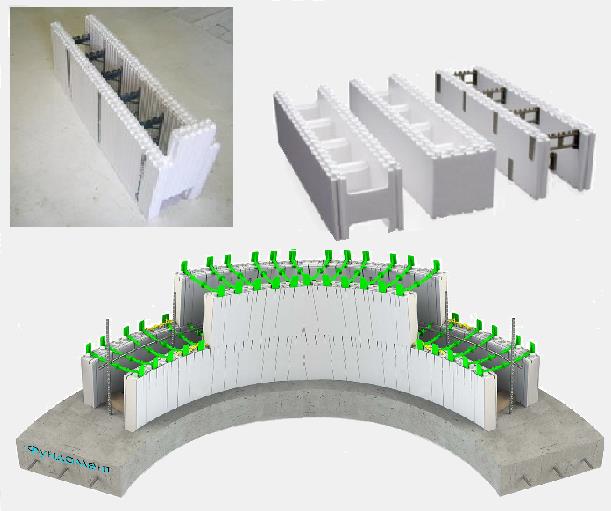So what is wall formwork? She is called a simple structure consisting of a number of type-setting panel blocks. These components are simply attached in the required position at a specific height and are needed to hold the concrete mixture until it is completely dry.
Per last years increased volumes monolithic construction, because of this, wall formwork has become the most needed and demanded auxiliary material. The popularity of monolithic buildings could be gained due to the speed of construction, excellent strength, and the ability to save on materials. In most cases, the formwork determines the high reliability of the structure made.
Any form consists of the following elements:
- bearing frame;
- fasteners;
- panel;
- stiffening rib.
There are 2 types of these forms:
- removable - it is removed after completion of work and solidification;
- the permanent formwork remains permanently.
More often, metal alloys and wood species with low moisture content are used to complete the shape.
Another form is classified:
- By size - large-panel and small-panel.
- By design - sliding, block-adjustable, volume-adjustable.
- For the purpose of use - vertical, horizontal.
To speed up the process of concrete hardening, plasticizers are added to the mixture. How is a wooden frame made?
Wood is the easiest and least expensive method of doing removable formwork... Formwork for walls made of wood is done as follows:
- with the help of bars with nails, the boards must be knocked down into shields of the required dimensions;
- shields need to be connected to one another, creating the shape of a future building.
The stationary form is 2 strips of boards with a distance for pouring concrete mixture. Shields can be removed and used later in other places. However, not all wood species may be suitable to establish the shape. Requires moisture-resistant wood with a moisture content of no more than 25%.
Metal carcass
It is made of 2 rows of metal sheets that are welded or riveted. Solid forms are fastened with pipe sections through which the bolts are passed. But this design is less suitable for wall formwork.
Plastic mold
Such frames, which have been developed recently, are a breakthrough in construction. And although with the help of such forms it will not be possible to make walls thicker than 40 cm, they can be perfect for filling the walls of a private cottage. Next, the manufacturing technology of the structure will be described.
Formwork for walls made of wood
For the device, only flat boards are suitable, on which there are no cracks and chips. The elements must be fastened with nails or screws from the inside out. The technology provides that spacers can be used to strengthen the structure, which will help protect the shape from deformation during the pouring of the concrete mixture.
If the wall formwork is poorly done or uneven boards are used, it will begin to let the concrete through. For this reason, it is better not to save on materials initially. The spacers are made of high-strength metal alloy.
The device can be dismantled after a few days. Timing depends on weather and humidity. The technology for removing the structure itself is as follows: you need to remove the form only after the concrete has completely solidified. will always be within the walls of the building, so you need to think about the appearance of this structure.
Now you know about wall formwork, their types and how to make this design do it yourself. Follow the tips above and you can create a solid shape for the walls of your home. We wish you good luck in making the walls of your future home.
The technology of private low-rise housing construction clearly does not stand still, numerous construction organizations have mastered a complex and rather effective method of erecting buildings using formwork for pouring walls. A method previously used exclusively in industrial and multi-storey construction, made it possible to completely remove the box of a two-story building in less than three weeks. The basis of high-speed construction is the use of standard sets of formwork for pouring walls, which make it possible to mechanize the slowest process that requires a large amount of highly qualified labor, namely, laying load-bearing walls houses.
For what purposes is formwork used in construction
Since the invention of reinforced concrete casting cement-sand mixture into the prepared form was the only one possible way quickly build a very durable and inexpensive building structure... Concreting into a prepared formwork allows you to automatically solve several difficult tasks:
- Giving the concrete mass the exact geometric dimensions and position relative to the steel reinforcement and other building elements;
- Pouring the concrete mixture into the formwork allows you to speed up the process at times and make it as simple and relatively inexpensive as possible;
- Application allows to obtain very strong and lightweight structures with minimal consumption of building material.
Note! The strength and thickness of the walls can be easily adjusted at the stage of preparation and assembly of the formwork for casting. At the same time, unlike other methods of forming walls, any thickness and shape can be made, with an accuracy of a millimeter, while brick and block structures are tied to the dimensions of masonry materials.

Types of formwork for pouring walls
Besides the famous and most popular lumber formwork, reusable metal formwork is widely used, different kinds permanent formwork for walls made of asbestos-cement sheets, slate, expanded polystyrene, sawdust-based composite materials, plastic. Disposable types are often used as insulation or finishing material for surface concrete wall.
Formwork design requirements
Regardless of the type and material of the formwork, the design of the form must meet the following requirements:
- Assembly and installation of walls, load-bearing elements, ties, supports, braces should be relatively simple and at the same time reliable, guaranteeing a strong connection;
- After pouring concrete, the structure should not deform, change proportions, lose tightness, swell, interact with the concrete material;
- The form should be easy to separate from concrete surface when dismantling after concrete has set;
- Whenever possible, accessories for wall formwork should be lightweight and accessible for carrying by one or two workers without the use of material handling equipment.
It is clear that due to the listed requirements, reusable wall casting structures are made of steel, aluminum or reinforced polypropylene. In addition to the long service life of metal and reinforced plastic, this kind of formwork, even after 50-70 assembly and disassembly cycles, provide stable dimensions of the casting thickness over the entire width and height of the mold.
Reusable Wall Pouring Mold Designs
Formwork is a set of elements that ensure the strength of the form, its constancy in the loaded state, the more intensively the mold is used for pouring the walls, the more components for wall formwork are included in such a structure. Reusable systems can be conditionally divided into two main groups - standard movable and universal formwork.
Reversible formwork is the simplest and most accessible form option. Usually it is three steel sheets, reinforced with stiffeners, and an even number of metal ties that connect the walls of the mold in a box structure. A fairly simple and even primitive device of such a formwork allows even an unprepared person to use it.

At the place where a part of the concrete wall is supposed to be cast, metal walls are installed along the marked contour and connected with screeds. The end surfaces of the mold are covered with removable overhead shields. After pouring such a shape and hardening the cement, the screeds are knocked out through the hole in the concrete, the metal walls are removed, rearranged to a nearby area, fixed and poured with concrete. In this case, the holes from the screeds on the old casting are used to fix the extreme fastening of the movable form before pouring the extension of the walls.

Universal systems are most in demand in flow schemes for building houses. The advantages include the ability to create a formwork that provides walls with a wide range of thickness and joint angle. The standard formwork kit includes:
- Sheet metal side panels reinforced with corner strips. Formwork surfaces are formed from the boards, therefore, with each installation, they are carefully aligned in the vertical and horizontal directions;
- Corner elements connect the side panels to form the corners of the building walls;
- Tightening screws, pivots provide fixing of the side panels at a certain distance from each other. The stability and uniformity of the thickness of the casting depends on the correctness of their installation after pouring the walls;
- The braces, most often telescopic, less often screw ones, ensure that the side panels are held in a stable position throughout the entire pouring process. Often, with the help of struts, the position of the formwork is adjusted and aligned.
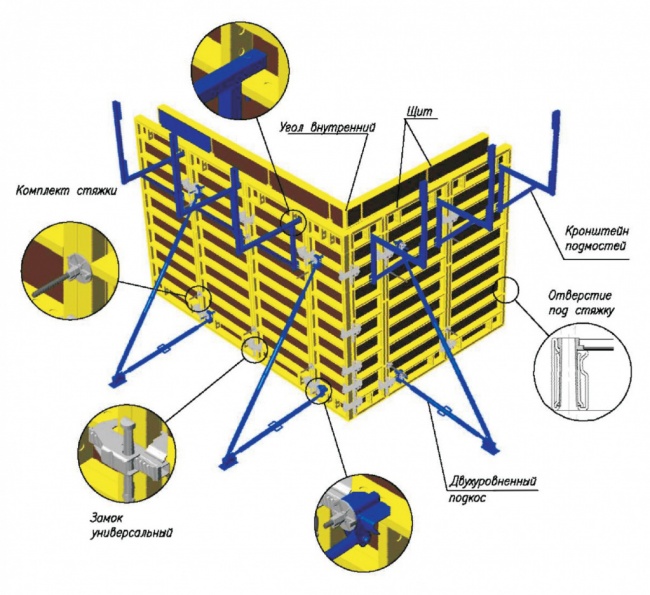
Note! Ease and speed of assembly and disassembly of reusable formwork is usually ensured by the use of wedge locks and stoppers. To disassemble such a form, it is enough to knock out the clips on the pins with a hammer and remove the struts.
After assembling the shields and installing pins and ties, before pouring, the set shape is adjusted vertically and horizontally. If the orientation of the formwork is correct, then the reinforcement rods released from the foundation or walls of the lower floor will be inside the form in the calculated position.
Fixed types of formwork
Such forms for pouring walls are used in cases where it is easier and cheaper to leave the formwork material on the concrete surface than to spend time and effort removing it. In many cases, the walls of the mold not only do not affect the quality of the casting, but also enhance it. The most common type of family of permanent formwork for walls of a house is expanded polystyrene and foam hollow blocks, in shape and size resembling foam concrete material.
![]()
After laying one or two rows of such blocks, bars of steel reinforcement are placed in the cavity and poured with concrete. After the concrete has set, a stone wall is obtained, covered with a layer of polystyrene foam. Foamed polystyrene foam will provide excellent noise and thermal insulation, but at the same time it remains a combustible material, therefore, the inner surfaces of the walls obtained by pouring in this way must be finished with cement-sand plaster or drywall. In addition to expanded polystyrene, non-removable types of formwork are made from compositions based on cement, sawdust and liquid glass.
This kind of formwork is considered to be safer, therefore, modern methods of pouring walls into non-removable forms, as a rule, use similar slabs and split forms. In any case, the formwork material must be finished with protective plastering compounds that minimize human contact with plastic and modified wood.
Formwork and molds for pouring lumber walls
Despite the immense popularity in the use of sawn timber, edged boards and beams for the manufacture of all kinds of structures for the basement parts of the walls, concrete castings of the foundation, pure wood is very rarely used to make molds for pouring the load-bearing walls of a house. Firstly, the use of a calibrated lath or lining for the assembly of panels will cost a tidy sum, and you cannot use an ordinary unedged board, since the surface of the casting will turn out to be uneven. For the foundation, the presence of imprints on the surface is not of particular importance and does not affect the strength of the casting.
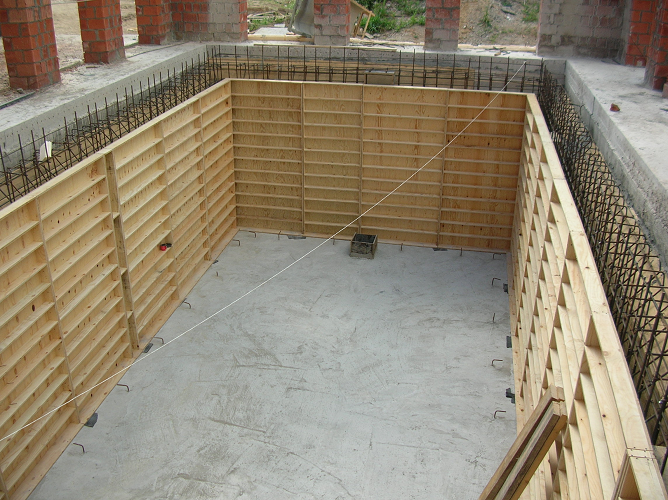
As an exception, one can cite the option when the formwork wall panels are made of laminated chipboard, or OSB. In this case, after pouring the concrete, very smooth and even wall planes are obtained, which practically do not require additional cleaning and trimming. With each pouring, the laminated surface is erased and partially deformed, over time it swells and peels off, therefore, the service life of such a wall mold is limited to 70-100 cycles.
Required for construction vertical slabs from concrete solution. It can be made from metal, wood or other hard material that does not change shape when the hardened concrete expands.
Advice: Do not allow deformation of the bearing planes or structural supports, which are the base of the future house, this can lead to an irreparable outcome.
For work, you can call the appropriate specialists who will bring everything you need and assemble the frame for pouring it with concrete. But they sometimes put forward inadequate prices that not everyone can handle. If you buy all the components yourself:
- you will have to pay less;
- the choice of materials is unlimited;
- after application, the materials can be used several times;
- apply them for another purpose.
Formwork types
According to the manufacturing method, they are:
- Simple - cheap, used everywhere
- Special - with a heater, used mainly in areas with low temperatures (the Far North, Siberia).

By the method of installation, they are divided into:
- Removable - can be stationary and movable.
- Fixed.
Both types are made from the following materials:
- tree - used everywhere;
- metal - used in large-scale construction;
- plywood - necessary for a frame made of strips or corners;
- plastic (polystyrene) - rarely used, mainly for non-removable structures.
All this can be purchased at a "flea market", fair or in a store, and the installation of wall formwork can be done independently. Both options are suitable for you, made of wood or plywood, as:
- boards, plywood and beams are quite easy to get;
- the price for them is low;
- installation is done quickly with a hammer, nails and a shovel.
Removable forms (stationary and movable)
These molds are made from wood, metal or plywood. Basically, a stationary structure is used during construction. But if you do not have the finance to buy enough material, or have a lot of time, you can perform a movable option.
Frame made of wood
Wood is the easiest and cheapest way to make removable concrete molds. After all, wall formwork from boards is performed as follows:
- with the help of bars and nails, the boards are knocked down into shields of certain sizes;
- shields are connected to each other, forming the shape of the future structure.
The stationary form consists of two rows of panels with a space for pouring concrete between them. For example, a square within a square, a rectangle within a rectangle for houses, or an oval within an oval for swimming pools.
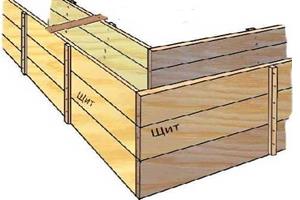

The shields can be safely removed and applied elsewhere. But not all types of wood are suitable for this. When making the solution, water is used, which changes the shape of the boards. They can warp, bend, swell and cannot be used a second time.
It is necessary to choose moisture resistant rocks with a moisture content of 25% and no more. For example, larch, alder, spruce, cedar. Although these rocks are expensive, you should not skimp, because you need smooth, strong walls that should stand for more than a dozen years.
Metal frame
The metal formwork is assembled from two rows of metal sheets that are riveted or welded. The resulting solid metal forms are held together by pipe sections through which the bolts are passed. And although these structures are not subject to change, such a do-it-yourself wall formwork is completely inappropriate.

Its price is an order of magnitude or two more than the cost of a wooden mold. Because of this, they are used in the construction of huge objects in which finances are invested with the calculation of their quick payback (stadiums, shopping centers, halls). But metal forms can be used in a movable version, which will be discussed below.
Plywood frames
Everyone knows that plywood is quite cheap, but flexible material and it is simply impossible to build a shape using this material alone, even if you take a sheet of 10 mm thick. But if you limit or cut off a part of the sheet, then the bending radius can be brought to almost zero.
There are two types of constructions to limit bending:
- External. Box-type frame made of reinforcement, sheathed on the outside with plywood. The disadvantage of this method is the large number of points of fastening of plywood sheets, which are necessary so that the concrete does not swell in one place or another.

Internal. Plywood sheets are inserted into a frame made of reinforcement or angles. This method is preferable, because the sheets can only be fastened at the corners. But a noticeable gain in fastening time has a serious drawback - it is necessary to purchase squares.
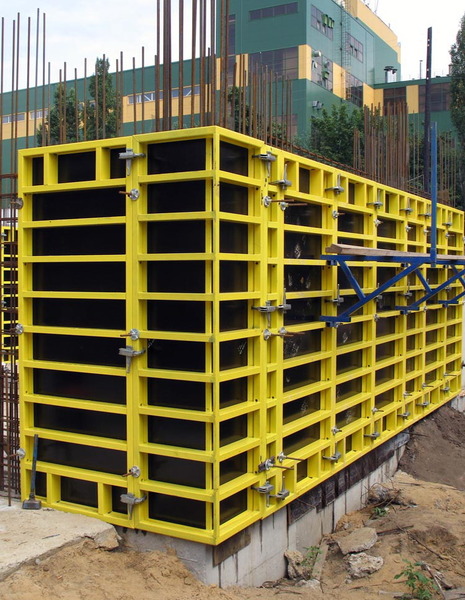
Plastic frame
The recently developed stationary plastic frames were a breakthrough in the construction business. And although they cannot be used to build a wall more than 40 cm thick, they are perfect for building your own home. It is very difficult to get them in stores.

If we compare it with traditional types (metal, wood), then plastic:
- almost an order of magnitude lighter - the weight is no more than 11 kg, and therefore carrying or transportation on a wheelbarrow is not difficult;
- quickly and easily mounted - fixed by turning the special handles at an angle of 90 ° and also easily removed;
- easy to use - easy to clean after dismantling;
- very economical - it is used more than 70 times, and retains its original shape for a long time;
- during storage, storage in a humid environment is possible;
- has a modular design, which allows you not to cut the panels to fit in size, since the elements vary in length. This helps by varying the panels to achieve the required dimensions of the future wall.
Installation and facilitated by special technological recesses, holes and sides. Notches are provided to accommodate standard commercially available spacers. Such spacers are also used for traditional frames.
Mobile frames
Installation can be done with less material. This is the case when you have:
- A lot of construction time.
- Lack of finance.
The movable variant represents the shape of a part of the wall and consists of:

Tip: To make the process of creating a wall faster, it makes sense to make 4 such structures, then you can build all the walls at once.
Fixed forms
Such forms are used mainly for the manufacture of already insulated walls. They are made of plastics, expanded clay concrete and other materials, which, when the concrete hardens, reliably "seize" with it.
It is easy to connect such shapes, because many of the block options are similar to the Lego figures for children. Some builders even refer to these blocks as "adult toys".
When using a non-removable construction form, be aware that it will remain forever on the hardened concrete. During its construction, heat-insulating blocks and materials are usually used, which serve not only as a formative element that determines the shape of the structure, but also to retain heat.
The main direction of this type is the construction of walls. A fragment of a non-removable structure is a hollow block with recesses and grooves on one side and special ribs or outgrowths on the other to provide a lock connection with the nearest blocks.
How to make wall formwork
Removable molds that are used many times are very beneficial for low-rise construction companies. Therefore, there are so few of them in specials. stores. Any of them is a kind of constructor, because during installation they use bolts, tubes, nuts, washers. It is necessary - collected. Finished business - disassembled and hid.
But for a person who for the first time faced with a problem hitherto unknown to him, it is very difficult to figure out:
- which one to choose - removable or non-removable;
- what material to buy - new or used, because it is cheaper;
- how to install.
To assemble the simplest type of removable form, it is necessary to use 2.5-5.0 cm boards (in thickness), the lengths of which are the same. Phased production and installation is carried out as follows:
- The length is measured (around the perimeter) and the amount of material is calculated. For example, if you: got boards 5 m long and 30 cm wide, and you are building a house with the following data:
- total area - 10x10 m 2 (side - 10 m),
- wall height - 3 m, width 0.25 m.
total length of external boards (along the perimeter) - Р1 \u003d 10 * 4 \u003d 40 meters;
total length of internal shields - P2 \u003d (10- (0.25 + 0.25)) * 4 \u003d 9.5 * 4 \u003d 38 meters;
the number of boards for the entire length of the boards - (P1 + P2) / 5 \u003d 78/5 \u003d about 16,
taking into account the cutting of boards in the corners, we take 20 pieces for the entire length of the boards;
the number of boards required for the height of the boards is 3 / 0.3 \u003d 10.
The total number of boards required to build a house is:
20 * 10 \u003d 200 pieces.
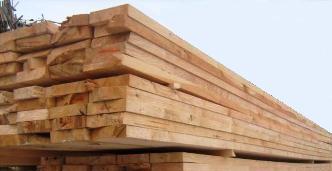
Three-meter bars (according to the height of your wall) will need 78-80 pieces. They are nailed every meter. Note that the corner beams must be longer - they are driven into the ground or inserted into the foundation holes that need to be punched. It is advisable, somewhere in the middle of the total length, to also provide and drive in long beams.
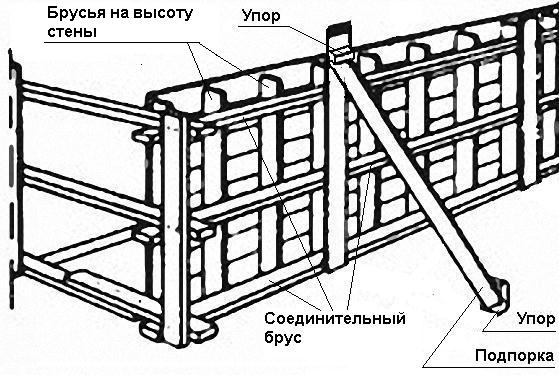
In addition, you will need beams to connect adjacent shields to each other, boards for props and pieces of beams for fastening external and internal shields.
- Shields are knocked down. Boards are laid on a suitable flat surface and knocked down with slats or beams. The length of the shield depends on the length of the boards, and the height should be equal to the height of the future wall or be slightly higher than it.
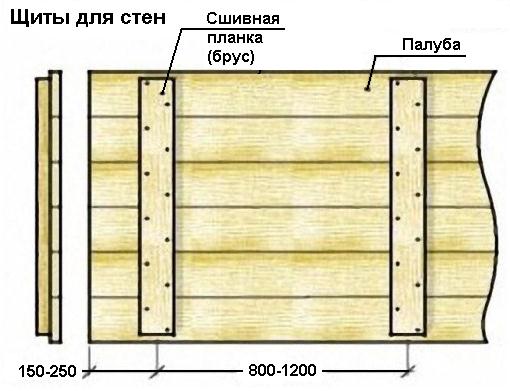
Please note that nails should be driven into the boards, not into the beams (stitching strips), that is, the caps should be on the flat side of the shield.
- Next, you need to knock the shields together with connecting beams.
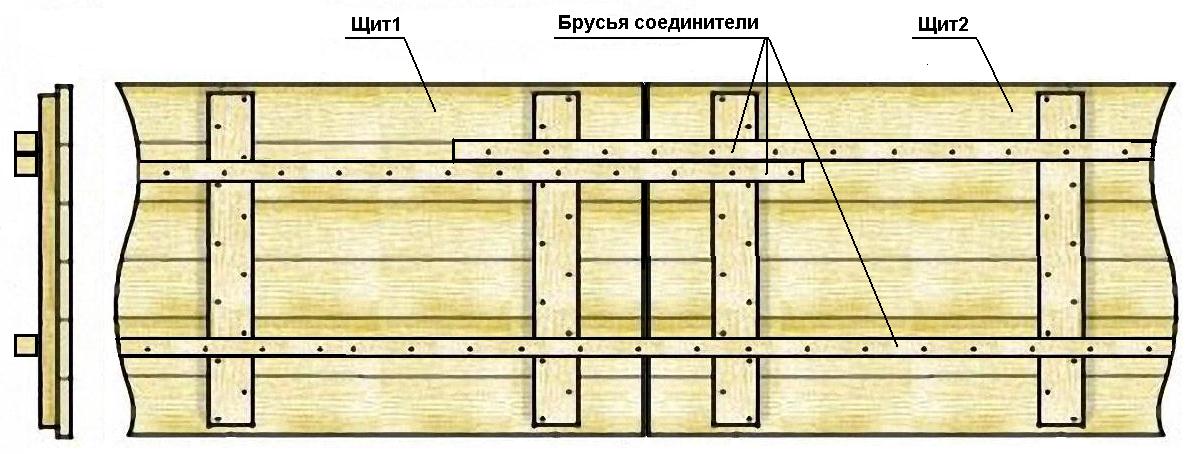
- In the corners of future walls (from the outside and inside):
- we drive in the corner beams into the ground, if we make a wall to the width of the foundation;
- if the wall is much smaller than the width of the foundation, then we punch holes in it and drive the beams into them. When pouring, it is possible to prudently insert pipe sections in the corners and, when performing the formwork, insert the beams into them.
- the bars of each corner must be aligned with a plumb line and knocked together with scraps of boards for rigidity
- We carry out installation of two rows at once:

- then the external boards are installed and the upper boards and the free side of both boards are connected with spacers made of pieces of beams;
- install supports and stops for the external shield.
- We pour concrete into the resulting structure.
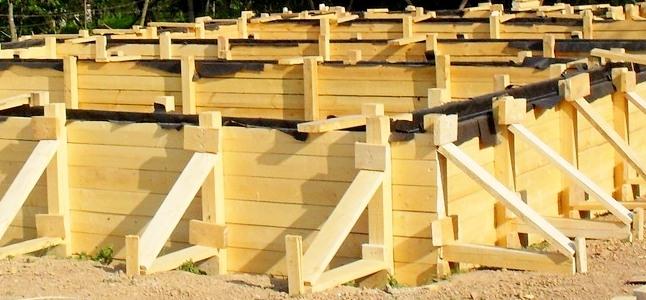
"Formworkers" on a note
- Before installation, everything must be accurately and meticulously measured. Do not forget that for the last floor of the house, the wall thickness should be at least 10 cm. And for each lower floor, preferably 3-5 cm more than the previous upper one.
- Use new materials to get smooth walls. For example, if you use old, even-looking boards, there is a danger of their bending when pouring concrete due to swelling, since this material has already been subjected to such a "wet" operation more than once.
- The basement of many houses is located at a height of 5 cm or more. To maintain this distance, use a board of the appropriate thickness.
- When fastening wooden formwork elements, use screws or nails. Try to drive them in so that the heads of the fasteners are on the inside of the structure.
- To enhance the resistance of the formwork to the action of poured and then hardening concrete, it is necessary to put spacers - inclined boards, resting one end against the formwork panels, and the other against the ground. The angle should be 30-45 degrees. Without spacers, all work can go down the drain.
- Make sure all top edges are parallel before pouring concrete. To do this, place the timber on the edges of the opposite formwork and check the horizontal level.
- Don't forget to use concrete plasticizers and vibrators. They increase the density of the finished wall a lot.
Using formwork from the materials described above, it is possible to build houses of different configurations, rearranging (if necessary) its elements from floor to floor. The main thing is not only the strength and reliability of the formwork, but also the simplicity of its construction and the possibility of quick assembly and disassembly of all component parts.
The use of factory formwork for walls is most often unprofitable. After all, its price is quite high, so it makes no sense to buy it for the construction of one building, even a rather large villa.
Of course, you can rent it, but in this case the highest possible pace of work must be ensured, which is also not always possible. Therefore, a private developer has only one option - do-it-yourself wall formwork, despite the fact that its installation may take longer than installing factory structures.
Manufacturing and installation of timber and sheet metal formwork
The whole process can be divided into several stages.
- We cut the prepared material to the required size.
- If a board is used, then it must be edged.
- The shields can be mounted on a metal frame or using ordinary transverse posts (with a low shield height). In the presence of a frame, the fastening of shields to each other in the same row is greatly simplified, but this makes the structure heavier and makes it more expensive. Elements are fastened with self-tapping screws or nails from the inside or inserted into the frame.
- We install the shields in place, fill the lower part with soil - this will ensure stability and prevent concrete leakage. All parallel shields must be tied together with special pins or wire.
- When installing the wall formwork, do not forget to connect the upper rows with jumpers. Check the correctness of the installation of each element during installation, in addition, it is necessary to control the position of the formwork relative to the axes of the buildings, the correct angles.
- Finally, we reinforce the frame with spacer sloping posts. When assembling the formwork, install pipe sleeves for the future introduction of communications, the diameter of the sleeves should be larger.
Wall mounting
Installation of expanded polystyrene formwork
Modern permanent formwork made of this material is distinguished by:
- reliability,
- ease of assembly,
- has excellent thermal insulation properties.
The use of such formwork reduces the installation time, it is a hollow element, assembled according to the principle of the constructor. Fastening of the wall formwork, its elements is carried out using special grooves on each block. Wall installation is carried out in the following order.
Modern formwork systems
The formwork blocks are put on the reinforcement, the outlets of which were made from the foundation. In special grooves, transverse reinforcement is laid, which connects the parallel walls of the formwork in each row. The voids of the blocks are filled with a concrete mixture made using fine filler fractions.
Do not forget to control the level of the formwork.
The advantage of this technology is also the fact that the casting of the walls into the formwork can be carried out in parallel, with a shift in time, ensuring the solidification of the mixture inside the blocks.
When finishing the day's work, make sure that the last row is half-filled, this will provide a more reliable joint with the next layer of concrete.
Permanent formwork construction
Dismantling the formwork
Formwork dismantling work can begin within a few days after the wall surface has formed and the surface layer of concrete has hardened. We start disassembling from the upper levels of the formwork.
First of all, the nuts on the studs connecting the parallel shields are unscrewed. After that, we remove the retaining slope posts on several elements. It is not worth removing them over the entire surface, the safety of the work is reduced, and uncontrolled destruction of the structure may occur.
After that, the locks connecting the elements are undocked. Removing the wall formwork, especially at a height, should be done with the utmost care to avoid accidents.
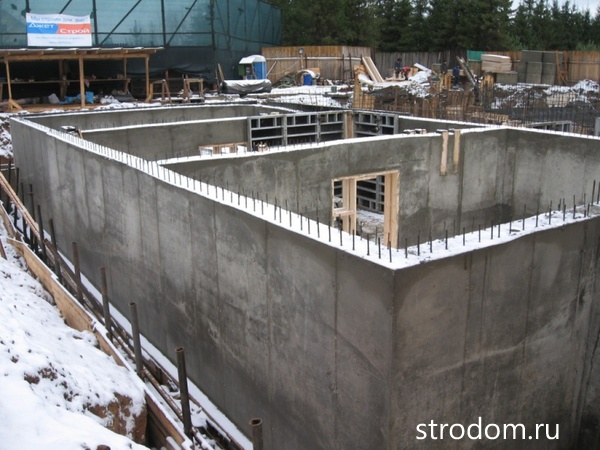
If, after removing the first shield, you are convinced that the concrete has hardened sufficiently, the wall surface is not disturbed, you can dismantle the rest of the formwork.
As you can see, there are no special difficulties when installing the formwork on your own, the main thing is to pay due attention to the reliability of the fastening and the correct arrangement of the elements along the planes. It is also necessary to control the straightness of the structure, which will affect the appearance of the walls. It is quite possible to do all this yourself, having construction skills and experience in conducting construction work.
Wall formwork is a simple and versatile device used for the construction of monolithic-frame buildings. With its help, you can significantly accelerate the pace construction works and improve the reliability and durability of the building.
Wall panel formwork - these are plywood panels with a frame made of a metal profile. It consists of type-setting blocks that are fixed in a given position and hold concrete mortar until completely solidified.
Basic set of removable formwork, the price of which may vary depending on the cost raw materials and the number of connecting parts, includes the following elements:
- Shields. They differ in fastening and can be linear or angular. Using special fasteners, an angular structure is assembled from linear (wall) panels.
- Fasteners. Screws and nuts for fixing the panels.
- Locks. With their help, shields are assembled and aligned.
- Braces. Shields are installed in them.
- Scaffold brackets. Organize a workplace.
In addition to the basic configuration, you can buy other formwork options, adapted to specific needs for each individual case. If the equipment is used extremely rarely, it will be possible to minimize costs by using rental services. For small objects, it is quite common to do wall formwork for pouring concrete yourself.

Depending on the material, there are the following varieties:
1. Wooden. Most often it is used in individual construction, it can be built with your own hands, since wood is much lighter than metal and easier to process.
2. Metallic. For large-scale construction, withstands more than 300 working cycles and a pressure of 8 tons per 1 square meter. The closed contour of the frame is made of steel or aluminum profiles. The first is the most durable and also the most resistant to deformation. Aluminum - lightweight and non-corrosive.
3. Plastic. Modular dismountable system, easy to maintain and does not require frequent use of lubricants, since plastic does not adhere to concrete. This is a formwork for high and non-standard walls, as composite materials can be radially bent into various shapes.
4. Polymer. This formwork is called fixed. It consists of hollow polystyrene foam blocks or two sheets of dense foam, between which there is space for pouring concrete, which, after cooling, forms monolithic wall with insulating properties.
The scope of use of such products is unusually wide. Their relevance is partly due to the fact that modern frame-monolithic technology construction is gradually replacing traditional methods. Not a single site, be it an industrial or private facility, is complete without formwork. It is indispensable for foundations, forcing walls, creating floors and decorative elements.

Installation features for different types
Pouring forms have their own classification, which depends on their size and purpose. structural elements... There are the following types of formwork:
1. Large panel. Reaches 3.3 m, it is used for the construction of long walls or in small construction to the height of one row. Steel structures are mounted using lifting equipment.
2. Small-board. Height - from 1 to 2.5 m, weight - no more than 50 kg. This allows you to install yourself using lifting mechanisms. It is universal, it is used for walls and other concrete elements of the building, ideal for small structures.
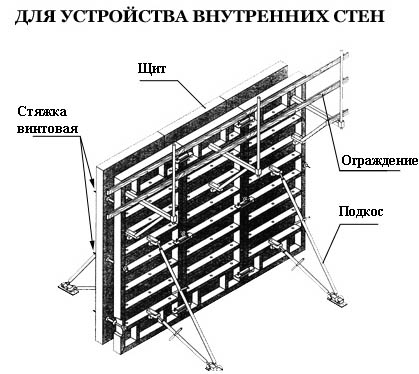
3. Blocky. Consists of individual volume-modular blocks, which can be rearranged around the entire perimeter and are suitable for the construction of internal or external walls.
4. Sliding. 3D mold for filling the full height of a multi-storey monolithic building tower type. As the concrete hardens, it moves upward using hydraulic jacks.
The installation of the formwork is carried out according to the scheme, which is spelled out in special documentation and agreed with the project. Assembled, it must be checked for cracks, reliability of joints and locks, as well as compliance with horizontal and vertical, for which a level, level and plumb line are used.
The installation process for different structures may have some differences. Regardless of the type and materials from which the wall formwork is made, it is necessary to firmly fix all its elements in a previously prepared place. The parts must fit tightly, and the walls of the mold must have adhesive properties and not deform under high pressure of a large mass of concrete.
Initially, the marking is made, which usually coincides with the reinforcing cage previously removed from the foundation. Angles are used as guides. A panel of shields is assembled, connected with special locks to the width of the wall, after which the plane is leveled and fixed with braces. Based on the specified thickness, the opposite side is set in parallel and fixed at the desired distance. Then screeds are installed along the upper edge, the scaffolds are combined and control measurements are taken.

![]()
average cost
Both large-scale construction organizations and individual developers can buy formwork panels, the price of which fluctuates in a wide range. In order to optimize costs, you can use rental services. Average cost indicators are shown in the table.
How to make do-it-yourself formwork?
For individual construction, a plastic or steel structure is a rather significant expense item, therefore it is most advisable to manufacture and install wooden formwork do it yourself. For this you will need:
- edged board, 3-5 cm thick;
- bars, section 20 x 20 and 100 x 100;
- tools.
The boards are knitted into a medium-sized shield to make it easy to move. The width depends on the size of the pouring area, but should not exceed 1.5 m. The boards are nailed to the base from the inside of the board, the surface of which should be painted or covered with a film to avoid the solution flowing and sticking to the wood.
In the places where two shields join, guide beams made of solid timber are driven into the ground. They must keep the block intact after the concrete is poured and protrude more than 25-30 cm above the planned height. The distance between the beams is approximately 1m. The formwork is additionally secured with transverse strips and diagonal struts, which make the structure reliable and fix all its elements. The construction of walls requires perfect proportions and precise geometry, therefore any type of wall formwork is mounted according to a pre-drawn scheme.


